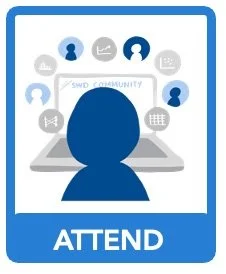WEEK 5: visual design
STEP 1 | Begin your week by joining us for our live lecture
We turn our attention back to graphs this week and learn how to take our visuals to the next level by applying the simple—yet powerful—design lessons. Join us for lecture on Monday, February 10 at 11AM ET.
You can watch the visual design lecture recording below:
READ | storytelling with you chapter 7
show data in graphs (pages 151–186)
When communicating data to support your message, it often means you should visualise it. This chapter shares the best practices for graphs in presentations, including an overview of data visualization design principles that will help ensure your data is easily understood.
STEP 2 | Review learning materials
choose a format that will help you learn best–select at least one from the section belowREAD | two tips for better graphs
There are measurable benefits to decluttering and focusing your audience’s attention when you communicate with graphs. This article shares tips on how to clean up your visuals along with steps on how to make the important points in your design stand out.
LISTEN | SWD podcast episode 65: EMPHASIZE it!
listening time 41:55
Tune in for practical tactics to create contrast visually and verbally, whether for important numbers or words, focusing attention within your table or graph, or communicating clear emphasis through how you speak and move.
WATCH | bringing data to life through pictures & story
viewing time 40:16
See the process of decluttering and focusing in a graph and also the power of moving from showing data to weaving it into a narrative through one of our all-time favorite presentations. This will get you to start thinking critically about story, which we’ll focus on more next week.
STEP 3 | Submit the weekly synthesize activity
required for certificate of completionSYNTHESIZE | apply this week’s learnings to your course project
If you haven’t yet done so, now is the time to start visualizing data for your course project. Complete the focus on the visual design of your project exercise (only visible to course participants). After posting your visual, browse what your classmates have shared and offer feedback.
STEP 4 | Explore optional resources to support your learning
OFFICE HOURS
We’ll have two sessions of office hours this week. These are optional sessions that you can join to ask questions or chat. Alternatively, if you aren’t able to attend a session this week you can submit a question here.
Meet with Simon on Thursday, February 13 at 4AM ET: register to attend
Meet with Amy on Friday, February 14 at 1PM ET: register to attend
Additional recommended resources
following lecture dive deeper into topics of your choosing
READ | strip away the non-essential
Stripping away the non-essential is a critical step along the path to communicate effectively with data. In this article, there are nine changes that help to eliminate clutter from this graph and ease the processing of the data.
WATCH | Excel tutorials
viewing time (videos range from 0:51 to 21:22)
Our Excel tutorials playlist includes a range of videos that demonstrate how to go beyond a default chart in Excel and create custom, effective graphs that make sense to someone else.
WATCH | How to focus attention in data visualization
viewing time 5:50
Cole shares & illustrates two simple steps you can take to make a better graph or slide for your next presentation.
LISTEN | SWD podcast episode 8: the many myths of data visualization
listening time 40:14 (transcript)
Have a listen to one of our most popular podcast episodes, where Cole discusses a number of myths (and a few rules) of data visualization. This extends beyond our specific theme this week, but will get you in the right frame of mind to start graphing data for your course project.
PRACTICE | SWD community exercise: bring this data to life
Here’s another chance to practice the holistic SWD process through a business case study: an order fulfilment analysis for a national retailer. Starting with an underwhelming visual, you’ll transform it into a data story that inspires action.
READ | SWD makeovers
Move beyond simply showing data with the collection of storytelling with data makeovers. Covering articles, videos and exercises, the makeovers collection transforms a series of real-world examples shared with us into data-driven stories.
Awesome work! You now understand—and have practiced—the important process of simplifying your visuals for explanatory purposes through eliminating unnecessary visual elements and focusing attention on what remains. A little time devoted here can have a big positive impact on your visual communications.
Next week… We’re going to talk about one of our favorite topics: story. See you then!


